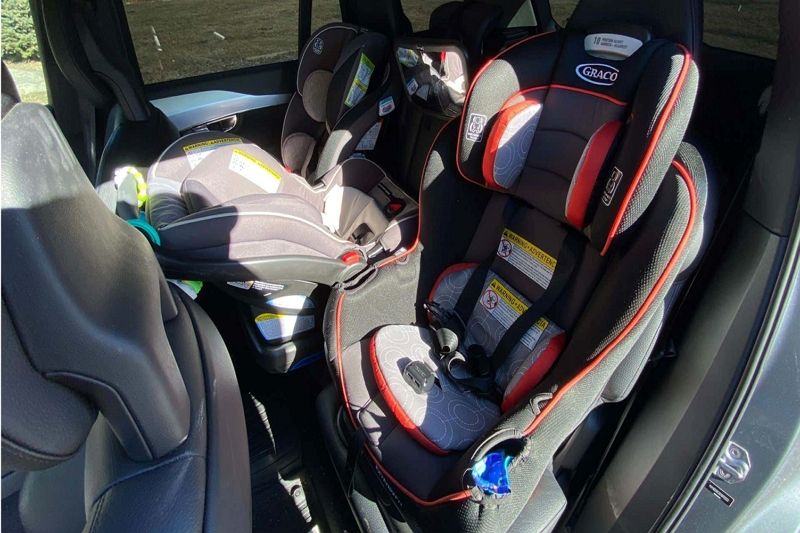When do you switch car seats? When your child outgrows a car seat, you need to switch them to the next size. Car seats range in weight and height limits. You must purchase one for your specific infant’s needs when they are born.
You should check with your local police station or fire department about what car seat laws may be in a place where you live so that can inform which product to buy if there are certain restrictions on age/weight/height guidelines of the baby’s booster seat.

For example, some places require children under 40lbs to use an orange label while others allow kids over 40lbs but less than 80lbs to ride without boosters at all! Ensure their safety by switching them between stages soon as it seems appropriate.
How long should a child be in a rear-facing seat?
Children should remain in a rear-facing child safety seat until they are at least two years of age AND weigh 20 lbs. Children’s bones, muscles and ligaments are not developed enough to endure the force of an impact during a car crash.
Rear-facing seats distribute this force evenly across the back, neck and shoulders while forward-facing seats put all that pressure on one small area where it can fracture or break more easily.
It is also safer for your toddler if you have them ride sitting higher up so they will be able to see out better through your windows instead of being hidden behind front seats.
Keep their little legs bent with knees under hips as much as possible so there isn’t too much pressure on soft spots like theirs which could cause permanent damage.
When can I legally forward face my baby?
The first time your baby is forward-facing will be around the age of two. It’s important to speak with your paediatrician about when your child should begin this transition, as every child develops differently and at different rates.
The minimum legal requirements for forward-facing are that your infant must weigh 20 lbs., plus or minus five pounds, and their height must be within the limits provided by the seat manufacturer (usually between 32 inches tall, up to 40 inches).
Even if they meet all these criteria though it doesn’t mean they’re ready yet! If after speaking with a certified car seat technician like one from Car Seat Inspections, there’s still some doubt in your mind then don’t hesitate to wait until another year before considering transitioning to forward-facing.
Rear-facing car seat laws by state
Currently, no federal laws are requiring the use of rear-facing car seats, but some states have passed their legislation.
The American Academy of Pediatrics recommends that infants and toddlers remain in a rear-facing seat until they reach the maximum height or weight for their seat. Some state child restraint laws require children to be facing backwards up to certain ages or weights, with fines given if caught not complying – however, none go by age alone.
While all 50 states have stricter front-seat passenger restrictions than just 14 years old, only 19 states plus D.C., Puerto Rico and Guam currently require kids under two to stay rear-facing per AAP guidelines: Alabama (under one year), California, Florida, Hawaii, Louisiana, Maine, Michigan (under two years), Mississippi, New Mexico (under two years), North Carolina, Oklahoma (under one year and 20 lbs.), Pennsylvania, South Dakota (under two years) and Utah.
Baby Car Requirements in the States of America
If you live in Texas or any other state, your baby car requirements will vary depending on the age of your child. The minimum amount of safety features required to drive a small vehicle with an infant is often less than what’s needed for older children.
Therefore, there are several different things that you’ll need to take into consideration if you want to transport an infant safely and legally while driving around town.
When should I switch my baby to a convertible car seat?
It is important to know when your baby should switch from a rear-facing car seat to a front-facing convertible car seat. The American Academy of Pediatrics (AAP) recommends that babies ride in the rear-facing position for as long as possible, and at least until they are two years old.
Some children will need to stay in the rear-facing position longer because their legs will not reach the back of the forward-facing vehicle seats or because they have medical conditions such as cerebral palsy that require them to be positioned upright during travel.
In addition, all infants may benefit from being kept lower than adults so if their feet touch an adult’s heels while sitting up it could cause discomfort on long trips. If you think about it, your baby is not much larger than a large watermelon.
If you place them in an upright position their head will move about and they could end up hitting the back of the vehicle seat or worse yet hit something outside of it if there is an accident.
How old do you have to be to sit in the front seat in California 2020?
California 2020 has made it illegal for people under the age of 20 to sit in front seats. There are exceptions, however, such as if you have a learner’s permit or medical needs that require you to keep your seatbelt off.
If there is no one else who can drive and assist with those needs then an adult must sit next to them in the backseat.
